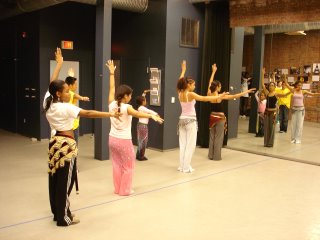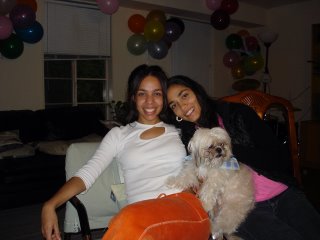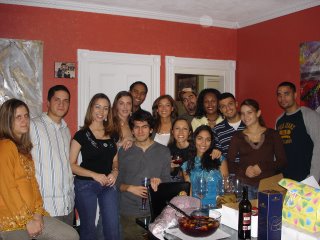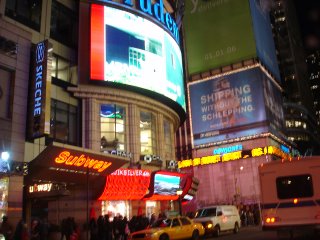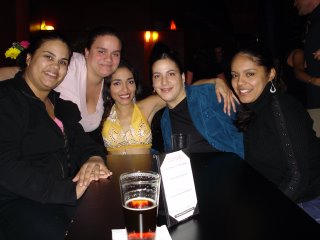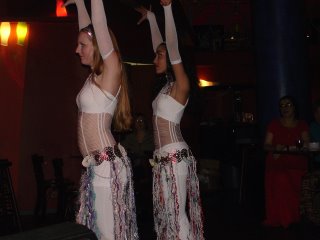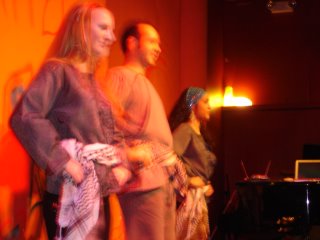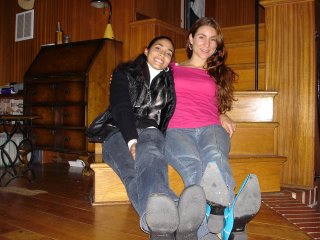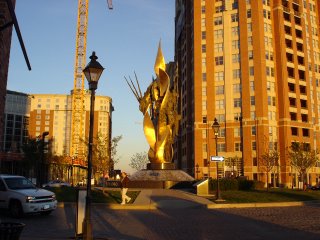Rock 'n' Roll Revolución
Here is the Article from the Boston Globe on the concerts we are putting on w/ the Zumix team in East Boston. We requested for the radio show & org name not to be mentioned - because at this point if the ratings get too high, the station would have to start paying fees - so we need to keep it low key for now.
Notheless is great press for the 'musical movement' we are attempting...
xoxo
RU
===========
Roc 'n rol revolución
From Eastie to JP, the sounds on the street are rocking, and they are in Spanish
By Christine MacDonald, Globe Correspondent November 27, 2005
Step inside the dimly lighted basement bar at the Kailua Hawaiian Restaurant in East Boston: Jeans-clad members of the neighborhood band La Chusma take the stage, wearing their electric guitars with attitude. Front man Juan Pedraza, in John Lennon glasses and a goatee, begins to work the room. The audience crowds the stage, singing along with every song though its members hail from a dozen Latin American countries. Striking the cool pose universal among rock fans, people wag their heads from side to side, keeping the beat. A few young men whip out cell phones and videotape the show. On this stage, there is no wall of horns and no snappy moves. Offstage, there is no dancing. Welcome to the transplanted world of Latin rock, appearing in a growing number of venues in Boston and environs. It's the sound of young Latin America, popular in the barrios of Buenos Aires, Lima, Santiago, Bogotá, and Mexico City. The music blends American and British rock influences with Latin American musical traditions. Lyrics run the gamut from love and loss to gritty urban realities like drug abuse and police brutality. In the US, with about a third of the country's 41 million Hispanics under 18, the Latin rock/pop genre accounted for nearly a third of an estimated $651 million in US Latin music sales last year, according to the Recording Industry Association of America.
Its emergence in the Boston area is a sign of a change in immigration patterns, with growing numbers of young newcomers arriving not from their homelands' countryside, as did most of their predecessors, but from the cities. For the young immigrants hankering for the pop culture soundtrack of the Latin American cities they left behind, Boston now stands ready, its Latin cover bands performing songs originally recorded by Latin Rock mega-groups such as Mexico's Maná, Chile's Los Prisioneros, and Argentina's Soda Stereo. ''I am a South American," said Bryan Alvarado, a 21-year-old from Lima. ''I love to dance salsa, merengue, and cumbia. But rock is the music of protest, the music of the city." Newcomers from countries with vibrant Latin rock scenes are adding layers of complexity to the region's already diverse Hispanic population. Puerto Ricans, Dominicans, and Salvadorans remained Boston's largest Hispanic groups in 2000.
While those communities continued to grow in the 1990s, Mexicans and Colombians arrived at an even faster clip, according to Census data analyzed by the Boston Redevelopment Authority. And previously untracked natives of Venezuela, Argentina, and Chile popped up in Boston Census counts for the first time in 2000. ''I think it's fascinating," said Edwin Argueta of the emerging Spanish rock scene. Argueta, 30 ,moved from El Salvador to the Boston area as a teenager. ''It's a different kind of a crowd. A lot of these folks who are immigrating here came from very urban scenarios. It's not what you saw in the late '80s and early '90s, which was mostly older folks from rural areas and with little education." Latin American rock dates back to the 1950s but entered the mainstream culture there in the 1980s and 1990s. Its rise in popularity down south -- and more recently in Boston -- has coincided with decades of rapid urbanization. Today Latin America is the world's most urban region, according to the World Bank. Compared to a world average of 49 percent, 77 percent of Latin America's population lived in cities and towns in 2003. Hector D. Fernandez, a Georgia State University professor and an expert on Latin rock, says the music is an urban middle class phenomenon that emerged from Mexico and Argentina and spread to other middle class urban centers around the region. While it was initially decried in some countries as an imperialist import, these days, he said, it is widely accepted as a commercially viable ''product" and a true Latin American musical form.
Medellin, Colombia, for instance, boasts a heavy metal scene. Mexico's Maldita Vecindad y los Hijos del Quinto Patio (which roughly translates into Damned Tenement and the children of the fifth floor) uses mariachi trumpets to achieve a punk rock sound. While Spanish rock has many musical influences, groups often share a rebellious rock-and-roll attitude. The music has taken on particularly militant tones to protest authoritarian governments, human rights abuses, and discrimination. ''The politics empowers the rock scene mostly," Fernandez said, pointing to Argentina's recent economic crisis and political upheaval, which he said has breathed new life into that country's rock scene lately. ''As the political situation gets worse and worse, it fuels the music."
Voices against violence
Colombia's Aterciopelados renounced the violence of their country's long-running civil war in the song ''Quemarropa" (Point Blank). ''No more, no more shooting that machine gun/No more, no more, stop the shooting, where did all the cold blood come from, always tempting heaven," go the lyrics. Los Fabulosos Cadillacs' 1993 hit ''Matador" memorialized Chilean poet Victor Jara, who was killed after General Augusto Pinochet seized power in a coup in 1973 that deposed Socialist president Salvador Allende. The lyrics: ''My words are bullets, bullets of peace, bullets of justice/Mine is the voice that they silenced without reason, only because I think differently." The Cadillacs follow in the path of Argentine rocker Charly Garcia, a critic of his country's military junta that ''disappeared" tens of thousands of people during that country's so-called ''Dirty War" in the 1970s and 1980s. Mexico's El Tri sang about government corruption and police brutality decades before free elections swept from power the country's authoritarian ruling party.
While the country has now held its first democratic elections, Daniel Rivas, 25, from Hermosillo, a northwestern Mexico city of 712,000 people, says being a Mexican rocker is still a rebellious act. ''In Mexico, rock is subterranean music -- it's underground," he said. ''If police see you with tattoos or long hair in Mexico, they stop and hassle you. There's no place to play." La Chusma bass player Mariana Iranzi, 27, said the music was less of a political statement and more a rite of passage growing up in Buenos Aires. There, ''everyone has a little band. Rock bands mostly," the Berklee student said. La Chusma members reflect the diversity of the local Hispanic community. Lead singer and guitarist Juan Pedraza, 30, is a ''chilango," or Mexico City native, who says the guitar transformed him from a nerdy schoolboy with thick glasses into a long-haired rocker who never left home without his guitar. From middle school until he dropped out of college, he says he paid all his school fees by singing cover songs on Mexico City buses. Today, he teaches guitar at an Eastie after-school program.
Sounds of success
Drummer Brian Leyva, 24, another Mexico City native, lives in Randolph and works in construction. He says his former band ''Perros de Pavlov" (Pavlov's Dogs) had a brush with fame in the 1990s, once opening for Los Fabulosos Cadillacs. Andres Ponciano, 22, who plays first guitar, is a Guatemalan native who recently graduated from Berklee. At 19, the band's youngest member, Carlos Saavedra graduated from East Boston High School last year and attends the New England Conservatory of Music. He grew up in the Boston area with his Peruvian-born parents and discovered rock in middle school when he heard John Lennon sing ''Imagine" on the radio. ''I went out and bought the album. After that I went out bought all his records. Then I learned that Lennon had a little group called The Beatles, and went out and bought all the albums," Saavedra said. But when he discovered Soda Stereo and other groups that sang in his native language, it opened up a world more appealing than the largely white and homogeneous one presented on the tube. ''When you are small your imagination takes off with the ideas they sell you on TV," Saavedra said. ''Music took me in a whole other direction." So far, Saavedra's band has played only occasional bar concerts in Chelsea and East Boston, community festivals, and private parties. They also have a new home of sorts on Radio 1630 AM, an East Boston community radio station that began broadcasting last summer. Volunteers launched the nightly ''Zubterraneo" Spanish rock show in September. Besides the music, Zubterraneo's audience shares a sort of pan-Latin American television culture. The Eastie band got its name from a Mexican soap opera in reruns throughout Latin America. Band members said the show acquired a youth following in the '80s and '90s similar to that of ''The Brady Bunch" in this country, only it was set in a ''vecindad," or poor neighborhood. ''There was this one character that was always saying 'chusma, chusma,' " which roughly translates into ''the poorest of the poor," Leyva said. ''We all remember that character."
Music moves upscale
While the name is fitting for the East Boston band, with its largely working-class fans, the scene that unfolds once a month at T.T. the Bear's Place in Cambridge is a more upscale affair. Those live concerts by local cover bands draw young Latin Americans seeking degrees at Harvard, MIT, BU and other area colleges, according to organizer Christian Hinojosa, who launched the concerts under the name ''Clandestino" (Clandestine) last year. ''There was no place to hear rock in Spanish. In Cambridge, the club owners weren't interested. They didn't think there was an audience," said said. But the first show was such a success the skepticism evaporated. ''The place was almost full," said Hinojosa, who celebrated Clandestino's first anniversary Sept. 23. Elena Balsa, 27, a UMass-Lowell graduate student from JP, was there, enjoying the rock she grew up listening to as a teenager in Merida, Venezuela, an Andean mountain city. Indeed, said Balsa, Latin rock here is largely a retro scene. Local cover bands cull their song lists from Latin rock's greatest hits from the 1980s and '90s, music fans like Gonzalo Scaramelli, 29, a cook from Lima, grew up with. ''Before the only option was salsa," said Scaramelli, now of JP, about the local Latin scene. ''But today the public is growing bigger and bigger" for Spanish rock. The reason is obvious to Juan Perez, 24, an East Boston warehouse worker, who arrived here from Colombia four years ago: ''This music is special because it's ours," said Perez, sipping a beer. Nearby, another young man raised his fist in the air, shouting: ''Que viva roc-n-rol!" And the crowd went wild in affirmation.
''Viva! Viva roc-n-rol!" Local Latin rock bands will next perform Dec. 9 at the Kailua Hawaiian restaurant, East Boston. For information, call 617-568-9777, ext. 16.
©Copyright 2005 The New York Times Company
Notheless is great press for the 'musical movement' we are attempting...
xoxo
RU
===========
Roc 'n rol revolución
From Eastie to JP, the sounds on the street are rocking, and they are in Spanish
By Christine MacDonald, Globe Correspondent November 27, 2005
Step inside the dimly lighted basement bar at the Kailua Hawaiian Restaurant in East Boston: Jeans-clad members of the neighborhood band La Chusma take the stage, wearing their electric guitars with attitude. Front man Juan Pedraza, in John Lennon glasses and a goatee, begins to work the room. The audience crowds the stage, singing along with every song though its members hail from a dozen Latin American countries. Striking the cool pose universal among rock fans, people wag their heads from side to side, keeping the beat. A few young men whip out cell phones and videotape the show. On this stage, there is no wall of horns and no snappy moves. Offstage, there is no dancing. Welcome to the transplanted world of Latin rock, appearing in a growing number of venues in Boston and environs. It's the sound of young Latin America, popular in the barrios of Buenos Aires, Lima, Santiago, Bogotá, and Mexico City. The music blends American and British rock influences with Latin American musical traditions. Lyrics run the gamut from love and loss to gritty urban realities like drug abuse and police brutality. In the US, with about a third of the country's 41 million Hispanics under 18, the Latin rock/pop genre accounted for nearly a third of an estimated $651 million in US Latin music sales last year, according to the Recording Industry Association of America.
Its emergence in the Boston area is a sign of a change in immigration patterns, with growing numbers of young newcomers arriving not from their homelands' countryside, as did most of their predecessors, but from the cities. For the young immigrants hankering for the pop culture soundtrack of the Latin American cities they left behind, Boston now stands ready, its Latin cover bands performing songs originally recorded by Latin Rock mega-groups such as Mexico's Maná, Chile's Los Prisioneros, and Argentina's Soda Stereo. ''I am a South American," said Bryan Alvarado, a 21-year-old from Lima. ''I love to dance salsa, merengue, and cumbia. But rock is the music of protest, the music of the city." Newcomers from countries with vibrant Latin rock scenes are adding layers of complexity to the region's already diverse Hispanic population. Puerto Ricans, Dominicans, and Salvadorans remained Boston's largest Hispanic groups in 2000.
While those communities continued to grow in the 1990s, Mexicans and Colombians arrived at an even faster clip, according to Census data analyzed by the Boston Redevelopment Authority. And previously untracked natives of Venezuela, Argentina, and Chile popped up in Boston Census counts for the first time in 2000. ''I think it's fascinating," said Edwin Argueta of the emerging Spanish rock scene. Argueta, 30 ,moved from El Salvador to the Boston area as a teenager. ''It's a different kind of a crowd. A lot of these folks who are immigrating here came from very urban scenarios. It's not what you saw in the late '80s and early '90s, which was mostly older folks from rural areas and with little education." Latin American rock dates back to the 1950s but entered the mainstream culture there in the 1980s and 1990s. Its rise in popularity down south -- and more recently in Boston -- has coincided with decades of rapid urbanization. Today Latin America is the world's most urban region, according to the World Bank. Compared to a world average of 49 percent, 77 percent of Latin America's population lived in cities and towns in 2003. Hector D. Fernandez, a Georgia State University professor and an expert on Latin rock, says the music is an urban middle class phenomenon that emerged from Mexico and Argentina and spread to other middle class urban centers around the region. While it was initially decried in some countries as an imperialist import, these days, he said, it is widely accepted as a commercially viable ''product" and a true Latin American musical form.
Medellin, Colombia, for instance, boasts a heavy metal scene. Mexico's Maldita Vecindad y los Hijos del Quinto Patio (which roughly translates into Damned Tenement and the children of the fifth floor) uses mariachi trumpets to achieve a punk rock sound. While Spanish rock has many musical influences, groups often share a rebellious rock-and-roll attitude. The music has taken on particularly militant tones to protest authoritarian governments, human rights abuses, and discrimination. ''The politics empowers the rock scene mostly," Fernandez said, pointing to Argentina's recent economic crisis and political upheaval, which he said has breathed new life into that country's rock scene lately. ''As the political situation gets worse and worse, it fuels the music."
Voices against violence
Colombia's Aterciopelados renounced the violence of their country's long-running civil war in the song ''Quemarropa" (Point Blank). ''No more, no more shooting that machine gun/No more, no more, stop the shooting, where did all the cold blood come from, always tempting heaven," go the lyrics. Los Fabulosos Cadillacs' 1993 hit ''Matador" memorialized Chilean poet Victor Jara, who was killed after General Augusto Pinochet seized power in a coup in 1973 that deposed Socialist president Salvador Allende. The lyrics: ''My words are bullets, bullets of peace, bullets of justice/Mine is the voice that they silenced without reason, only because I think differently." The Cadillacs follow in the path of Argentine rocker Charly Garcia, a critic of his country's military junta that ''disappeared" tens of thousands of people during that country's so-called ''Dirty War" in the 1970s and 1980s. Mexico's El Tri sang about government corruption and police brutality decades before free elections swept from power the country's authoritarian ruling party.
While the country has now held its first democratic elections, Daniel Rivas, 25, from Hermosillo, a northwestern Mexico city of 712,000 people, says being a Mexican rocker is still a rebellious act. ''In Mexico, rock is subterranean music -- it's underground," he said. ''If police see you with tattoos or long hair in Mexico, they stop and hassle you. There's no place to play." La Chusma bass player Mariana Iranzi, 27, said the music was less of a political statement and more a rite of passage growing up in Buenos Aires. There, ''everyone has a little band. Rock bands mostly," the Berklee student said. La Chusma members reflect the diversity of the local Hispanic community. Lead singer and guitarist Juan Pedraza, 30, is a ''chilango," or Mexico City native, who says the guitar transformed him from a nerdy schoolboy with thick glasses into a long-haired rocker who never left home without his guitar. From middle school until he dropped out of college, he says he paid all his school fees by singing cover songs on Mexico City buses. Today, he teaches guitar at an Eastie after-school program.
Sounds of success
Drummer Brian Leyva, 24, another Mexico City native, lives in Randolph and works in construction. He says his former band ''Perros de Pavlov" (Pavlov's Dogs) had a brush with fame in the 1990s, once opening for Los Fabulosos Cadillacs. Andres Ponciano, 22, who plays first guitar, is a Guatemalan native who recently graduated from Berklee. At 19, the band's youngest member, Carlos Saavedra graduated from East Boston High School last year and attends the New England Conservatory of Music. He grew up in the Boston area with his Peruvian-born parents and discovered rock in middle school when he heard John Lennon sing ''Imagine" on the radio. ''I went out and bought the album. After that I went out bought all his records. Then I learned that Lennon had a little group called The Beatles, and went out and bought all the albums," Saavedra said. But when he discovered Soda Stereo and other groups that sang in his native language, it opened up a world more appealing than the largely white and homogeneous one presented on the tube. ''When you are small your imagination takes off with the ideas they sell you on TV," Saavedra said. ''Music took me in a whole other direction." So far, Saavedra's band has played only occasional bar concerts in Chelsea and East Boston, community festivals, and private parties. They also have a new home of sorts on Radio 1630 AM, an East Boston community radio station that began broadcasting last summer. Volunteers launched the nightly ''Zubterraneo" Spanish rock show in September. Besides the music, Zubterraneo's audience shares a sort of pan-Latin American television culture. The Eastie band got its name from a Mexican soap opera in reruns throughout Latin America. Band members said the show acquired a youth following in the '80s and '90s similar to that of ''The Brady Bunch" in this country, only it was set in a ''vecindad," or poor neighborhood. ''There was this one character that was always saying 'chusma, chusma,' " which roughly translates into ''the poorest of the poor," Leyva said. ''We all remember that character."
Music moves upscale
While the name is fitting for the East Boston band, with its largely working-class fans, the scene that unfolds once a month at T.T. the Bear's Place in Cambridge is a more upscale affair. Those live concerts by local cover bands draw young Latin Americans seeking degrees at Harvard, MIT, BU and other area colleges, according to organizer Christian Hinojosa, who launched the concerts under the name ''Clandestino" (Clandestine) last year. ''There was no place to hear rock in Spanish. In Cambridge, the club owners weren't interested. They didn't think there was an audience," said said. But the first show was such a success the skepticism evaporated. ''The place was almost full," said Hinojosa, who celebrated Clandestino's first anniversary Sept. 23. Elena Balsa, 27, a UMass-Lowell graduate student from JP, was there, enjoying the rock she grew up listening to as a teenager in Merida, Venezuela, an Andean mountain city. Indeed, said Balsa, Latin rock here is largely a retro scene. Local cover bands cull their song lists from Latin rock's greatest hits from the 1980s and '90s, music fans like Gonzalo Scaramelli, 29, a cook from Lima, grew up with. ''Before the only option was salsa," said Scaramelli, now of JP, about the local Latin scene. ''But today the public is growing bigger and bigger" for Spanish rock. The reason is obvious to Juan Perez, 24, an East Boston warehouse worker, who arrived here from Colombia four years ago: ''This music is special because it's ours," said Perez, sipping a beer. Nearby, another young man raised his fist in the air, shouting: ''Que viva roc-n-rol!" And the crowd went wild in affirmation.
''Viva! Viva roc-n-rol!" Local Latin rock bands will next perform Dec. 9 at the Kailua Hawaiian restaurant, East Boston. For information, call 617-568-9777, ext. 16.
©Copyright 2005 The New York Times Company

